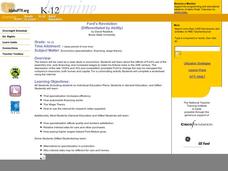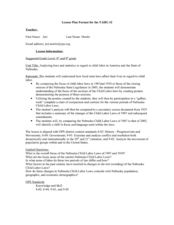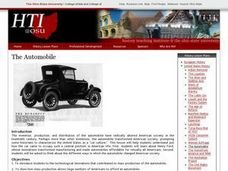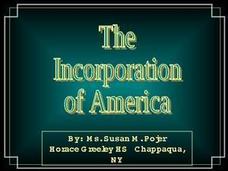Curated OER
Paper Production
Students compare paper making by hand and by assembly line. In this manufacturing instructional activity, students compare and contrast the two main ways to make paper, by hand or by machine. Students research paper making and have...
Curated OER
Ford's Revolution
Industrialization and mechanization of products such as cars have deeply affected the US economy. The class discusses the affects of Ford's assembly line production of automobiles. They watch a video, fill out worksheets, and investigate...
Curated OER
Mass Production Using an Assembly Line
Fifth graders examine the industrial revolution. In this industrialization lesson, 5th graders explore the concept of mass production via the assembly line. They then create an assembly line which demonstrates its costs and benefits...
Curated OER
Assembly Line
Pupils explore the benefits of using the assembly line method of production rather than the conventional factory method. They create animals in the assembly line method. Students are assigned a certain task to do in order to complete the...
Curated OER
Quilting Bee-Assembly Line Style
Students identify the roles of a producer and a consumer. In this economics lesson, students define the roles of a consumer and producer and produce a quilt using an assembly line.
Curated OER
Assembly Line Burgers
Students explore the reasons why the assembly line was formed and how it improves productivity. They practice with their own assembly line by making "burgers" out of wafers and frosting.
Curated OER
Interchangeable Parts Revolutionize Clock-making
Students consider assembly line production. In this lesson on Industrialization, students explore rifle manufacturing then create a workshop in the classroom to assemble clocks. They determine the pros and cons of assembly line...
Curated OER
Henry Ford and Assembly Line Production
Students study Henry Ford and the imprtance of the history of automotives. They participate in learning stations to assemble diagrams simulating an assembly line. They produce pictures at each station and pass the picture on to the next...
Curated OER
On the Line
High schoolers view a television program that traces the use of the assembly line in mass production and the subsequent conflict between workers' rights and management. They analyze and discuss the portrayal of the American worker over...
Curated OER
Community Helpers
First graders explore the different products and services provided by community helpers. In this community helpers instructional activity, learners participate in a role playing activity where the students transform into community...
Curated OER
Henry Ford
Third graders study Henry Ford and his invention of the assembly line. They write about the differences between cars of the past and the cars they see in their community today. They take a fieldtrip to the Henry Ford Mansion.
Curated OER
Writing Crazy Crayons
Second graders observe the workings of an assembly line. They classify old crayon pieces by color, melt them in candy molds, package them, and produce advertising literature to sell the product. Students share their work with the class.
Curated OER
Child Labor
Students examine how how groups and institutions work to meet individual needs and promote the common good, and identify examples of where they fail to do so. They describe how workers with specialized jobs and the ways in which they...
Curated OER
An Incredible Journey: Exploring Brave New Worlds
Students, after reading the novel, Brave New World, research in depth topics like the production and consumption of Henry Ford, Pavlov's and Skinner's behavioral science work, as well as the existence of Utopian and dystopian societies....
Curated OER
The Roaring Twenties
Let's take a look back at America during the 1920s and 1930s. Information regarding the economics in the 1920s that led to some of the issues during the 1930s are covered using text and images. Learners will consider economic booms,...
Curated OER
The Automobile
Students are introduced to technological innovations that contributed to mass production of the automobile and how this allows large numbers of Americans to afford an automobile.
Curated OER
The Incorporation of America
The incorporation and industrialization of America is covered in this image-rich slide show. While text is limited, there is no shortage of great images showing the progression and causes of American Industrialization. Perfect...
Curated OER
Technology: Mass Production and Standardization
Students explore standardization and mass production by creating verbal visual vocabulary tables. They discover how industrial inventions increase profits for businesses. Students create three-tiered definition concept trails using...
Curated OER
Producing and Consuming
Second graders make a booklet. In this economics lesson, 2nd graders define producers and consumers. They make an assembly line accordion booklet to demonstrate how producers and consumers work together to make and use goods.
Winston-Salem Forsych County Schools
Economics Worksheet Economic Systems and Circular Flow
Agribusiness, human capital, productivity. Find out what your class members know about economic systems and terminology with this two-page economics worksheet that that asks kids to identify terms and concepts.
Curated OER
Ford's Revolution (Differentiated by Ability)
Students explore the effects of Ford's use of the assembly line, auto financing, and increased wages to make his fortune. They complete a worksheet using the internet.
School Improvement in Maryland
Socio-Economic Goals of the Government
Equity. Increased productivity. Price stability. Environmental protection. Decreased poverty. Governments establish socio-economic goals and then must design and fund programs to address these goals. Groups investigate various...
Curated OER
Division of Labor
Students explore cottage industry and division of labor. They study the Industrial Revolution and its effects on workers and productivity.
Curated OER
The History of Ethanol in America
Sixth graders explore and examine the production of biofuels from the 1850's to the present. Included in their research is Henry Ford, ethanol, World War I and prohibition. They explain the importance of grains and grasses for the...























